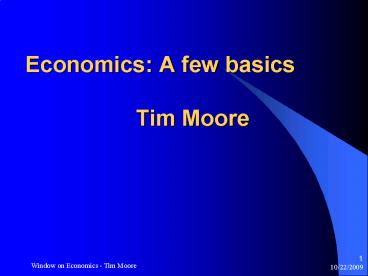Economics: A few basics Tim Moore - PowerPoint PPT Presentation
1 / 24
Title:
Economics: A few basics Tim Moore
Description:
This is a brief overview that may helps you engage with economics and economists ... Go beyond economic rationalism' Sometimes explicit, although often implicit ... – PowerPoint PPT presentation
Number of Views:103
Avg rating:3.0/5.0
Title: Economics: A few basics Tim Moore
1
Economics A few basics Tim Moore
2
The purpose today
- This is a brief overview that may helps you
engage with economics and economists for the rest
of the workshop (and in the future) - Two elements
- Understanding and critiquing economics
- Some basic concepts
3
1. Understanding and critiquing economics
4
From here
- What is economics?
- How to grapple with it?
- Sources of further information
- Particularly relevant areas
5
What is economics?
- Many things are attributed to economic reasons
- There is a political rhetoric
- Use can be inconsistent
- The way I view economics
- A method of allocating resources
- A thorough way to take account of many groups and
secondary effects (at its best) - Can enable decisions to be made
6
Economic concepts
- What are the values?
- Go beyond economic rationalism
- Sometimes explicit, although often implicit
- Utilitarianism is common
- Weight to what can be observed
- Often bias to the status quo
- Income, consumption become key
7
Economic concepts
- What are the assumptions involved?
- They are often implicit
- What is the scope of the argument?
- Economic concepts often involve
- Interaction of variables (Eg. Demand and supply)
- Secondary effects
- Trade-offs
8
Economic concepts
- There are often multiple concepts within an
argument break them down - Look at your own economic experience
- Look at several explanations or views
- There is often a plurality of views and
approaches among economists
9
Critiquing concepts
- Are the values appropriate?
- Are the assumptions valid?
- What happens if they dont hold?
- Is there a false precision?
- Is the scope correct?
- Are things missing (eg. environment)?
- Is there overreaching?
- Look at arguments/concept/relationships
individually as much as possible
10
Dealing with data and models
- Is the data appropriate?
- Is there some other explanation for it?
- Is there another source of information?
- Measures are often linked (eg. income equals
spending equals production) - Is there background information?
- Was there sensitivity analysis done?
- For data or modelling results Do the figures
make intuitive sense?
11
Some examples
- Look at data presentation critically, ideally
checking data source if you have doubts look at - Length of time used
- Proportional vs. absolute
- Values on axes
- Example Female employment in 1984 (Aust Bureau
of Statistics)
12
1. Female employment as a percentage of the
total population
13
2. Stretching the axis
14
3. Absolute growth in female employment (same
data)
15
4. Shifting previous graph forward by a month
16
2. Some basic concepts
17
One to rule them all
- Opportunity cost what you could have got with
your money or resources (time, land, etc.) - Comprehensive measure
- Is how economics differs to accounting
18
How are decisions made?
- Whatever maximises (social) welfare
- Consists of
- (Economic) profit
- Utility
- Utilitatarian monetise how everyone is placed
and add up
19
Demand and supply
- Demand (schedule) total that people are willing
to buy (marginal benefit) at each price - Changed by
- Income
- Substitutes and complements
- Preferences
- Population
- Future prices
20
Demand and supply
- Supply (schedule) total that people are willing
to sell (marginal cost) at each price - Changed by
- Technology
- Prices of inputs
- Prices of related goods
- Number of suppliers
- Expected future prices
21
Related concepts
- Equilibrium
- Efficiency
- Public goods
- Externalities
22
Other concepts
- Real vs. nominal
- Marginal vs. average
- Stock vs. flows
- Direct vs. indirect (multipliers)
- Now vs. future
- Interest rates, discount rates
23
Sources of information
- Productivity Commission, www.pc.gov.au
- NSW Treasurys interstate comparison of taxes
- http//www.treasury.nsw.gov.au/indexes/pubs_by_pol
.htm - Australian Bureau of Statistics
- http//www.abs.gov.au and their helpline
- Reserve Bank of Australia
- http//www.rba.gov.au
- Budget papers
24
Sources of information
- Window on Economics, www.ozprospect.org/window
- Melbourne University Econcochat, etc.
- http//www.economics.unimelb.edu.au/economics.htm
- Resources for Economists on the Internet (US)
- http//www.aeaweb.org/RFE/EconFAQ.html































